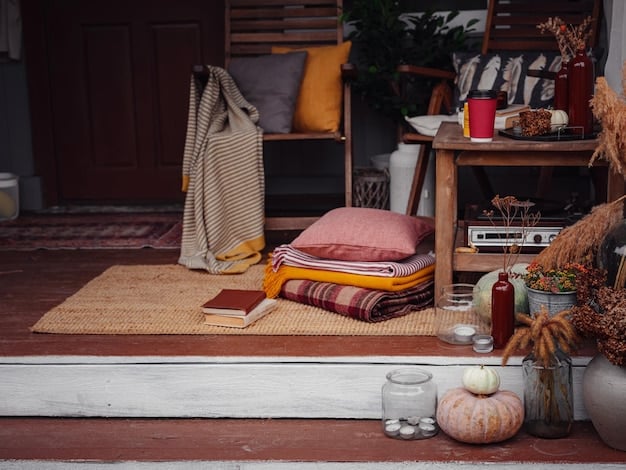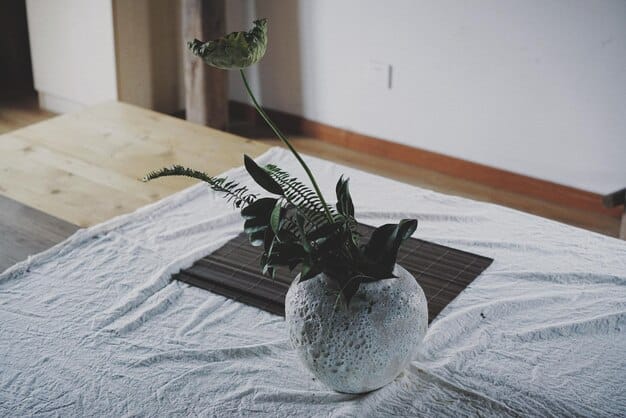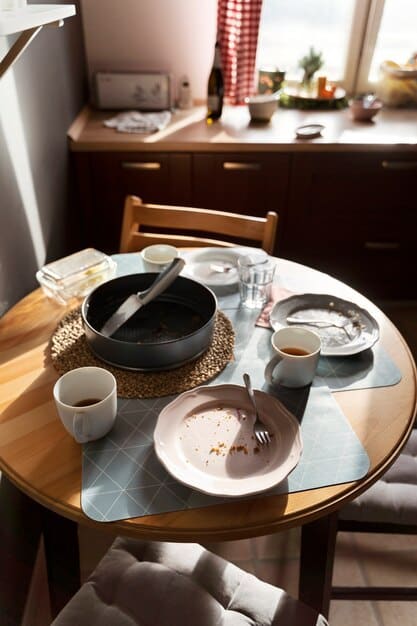Korean Drama Inspired Decor: 5 Ways to Bring K-Drama Aesthetics Home

Anúncios
Korean drama-inspired interior design offers a harmonious blend of minimalism, natural elements, and cozy accents, perfectly capturing the essence of comfort and style seen in popular K-dramas, easily adaptable into any home for a touch of Korean aesthetics.
Anúncios
Obsessed with the serene and stylish homes featured in your favorite K-dramas? You can easily bring the charm of Korean drama-inspired interior design into your own space with these five simple and elegant decor tips.
Embrace the Minimalist Aesthetic
Korean interior design, heavily influenced by Zen principles, emphasizes simplicity and functionality. Embracing minimalism doesn’t mean sacrificing comfort, but rather focusing on what truly enhances your living space.
Anúncios
Declutter and Simplify
Start by decluttering your space. Remove unnecessary items and keep only what you need and love. Storage solutions are your best friend here.
- Invest in minimalist storage: Opt for sleek, hidden storage solutions to keep clutter out of sight.
- Reduce visual noise: Pare down on decorative items, choosing a few meaningful pieces instead of many.
- Keep surfaces clear: Maintain clean countertops and tables to create a sense of calm.
A minimalist approach opens up your space, creating a peaceful and inviting atmosphere that’s characteristic of Korean drama settings.

Incorporate Natural Elements
Nature plays a vital role in Korean culture, and this is reflected in interior design. Incorporating natural elements brings warmth and tranquility into your home.
Wood and Plants
Wood is a staple in Korean design, often used for flooring, furniture, and accents. Plants add life and color while purifying the air.
Choose wooden furniture with clean lines and natural finishes. Introduce plants like bamboo, succulents, or small trees to create a calming environment.
Natural Light
Maximize natural light to create an airy and bright space. Sheer curtains allow light to filter through while maintaining privacy.
Use light-colored window treatments and position furniture to take advantage of natural light sources. Avoid heavy drapes that block sunlight.
By bringing the outdoors in, you create a harmonious and revitalizing living space that resonates with Korean aesthetic principles.
Opt for Low Furniture
Low furniture is another key element of Korean interior design. It creates a sense of spaciousness and encourages relaxation.
Floor Seating and Low Tables
Traditional Korean homes often feature floor seating and low tables for dining and socializing. Incorporating these elements can transform your living space.
- Floor cushions: Use floor cushions instead of chairs for a casual and comfortable seating arrangement.
- Low coffee tables: Opt for a low coffee table as a focal point in your living room.
- Platform beds: Consider a low platform bed for a minimalist and relaxing bedroom setup.
Adopting low furniture encourages a more grounded and relaxed lifestyle, reminiscent of the easygoing environments portrayed in Korean dramas.
Use a Neutral Color Palette
A neutral color palette is essential for achieving a Korean-inspired interior. Soft, muted tones create a serene and timeless atmosphere.
Whites, Grays, and Beiges
Whites, grays, and beiges form the foundation of a Korean color scheme. These colors create a calming backdrop for your furniture and decor.
Use these neutral tones for walls, flooring, and large furniture pieces. Accents of natural wood and greenery will add warmth and texture.
Pastel Accents
Subtle pops of pastel colors can add a touch of personality without disrupting the overall tranquility. Think soft blues, pinks, and greens.
Incorporate pastel accents through cushions, throws, or artwork. Avoid bold and vibrant colors that can overwhelm the space.
By sticking to a neutral color palette with gentle accents, you can achieve a sophisticated and serene atmosphere, reflecting the understated elegance of Korean interiors.

Incorporate Traditional Patterns and Textiles
While modern Korean interior design leans towards minimalism, incorporating traditional patterns and textiles can add depth and cultural richness.
Geometric Patterns
Look for geometric patterns inspired by traditional Korean designs. These can be incorporated through textiles, wallpaper, or artwork.
Natural Fibers
Choose natural fibers like cotton, linen, and silk for your textiles. These materials add texture and comfort to your space.
- Rugs and mats: Use woven rugs or mats to add warmth and texture to your floors.
- Bedding: Opt for bedding made from natural fibers like linen or cotton.
- Upholstery: Choose furniture with natural fiber upholstery for added comfort and style.
Incorporating traditional patterns and textiles adds a layer of cultural authenticity, creating a space that feels both modern and deeply rooted in Korean heritage.
Pay Attention to Lighting
Lighting plays a crucial role in setting the mood of your Korean-inspired interior. Soft, warm lighting creates a cozy and inviting atmosphere.
Ambient Lighting
Focus on ambient lighting to create a warm and inviting glow. Use lamps with warm-toned bulbs and avoid harsh overhead lighting.
Lamps with paper or fabric shades can diffuse light and create a soft, gentle ambiance. Dimming switches allow you to adjust the lighting to suit your mood.
Natural Lighting
Take advantage of natural light as much as possible. Keep windows clear and use sheer curtains to filter sunlight.
Mirrors can also be used to reflect natural light and brighten up your space. Position mirrors strategically to maximize their effect.
Good lighting design is essential for creating a comfortable and aesthetically pleasing space that embodies the serene and welcoming atmosphere of Korean dramas.
| Key Concept | Brief Description |
|---|---|
| 🏠 Minimalism | Focus on simplicity, decluttering, and functional spaces. |
| 🌿 Natural Elements | Incorporate wood, plants, and maximize natural light. |
| 🛋️ Low Furniture | Use floor seating and low tables for a relaxed feel. |
| 🎨 Neutral Colors | Employ whites, grays, and pastels for a serene ambiance. |
FAQ
▼
Key elements include minimalism, natural materials, low furniture, neutral color palettes, and incorporating traditional patterns and textiles. The focus is on creating a peaceful and functional space.
▼
Incorporate wood furniture, plants like bamboo and succulents, and maximize natural light. Use sheer curtains to filter sunlight and create an airy environment that feels relaxing.
▼
Low furniture creates a sense of spaciousness and encourages relaxation. Traditional Korean homes often feature floor seating and low tables. Consider platform beds for a minimalist feel.
▼
Use a neutral color palette with whites, grays, and beiges. Introduce soft pastel accents through cushions, throws, or artwork. Avoid bold and vibrant colors for a calming effect.
▼
Incorporate geometric patterns inspired by traditional Korean designs through textiles, wallpaper, or artwork. Use natural fibers like cotton, linen, and silk for textiles to add texture.
Conclusion
Bringing Korean drama-inspired interior design into your home is about creating a harmonious and functional space that reflects tranquility and simplicity. By embracing minimalism, incorporating natural elements, opting for low furniture, using a neutral color palette, and adding traditional touches, you can transform your home into a stylish and serene haven inspired by the beautiful settings seen in your favorite K-dramas.





